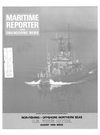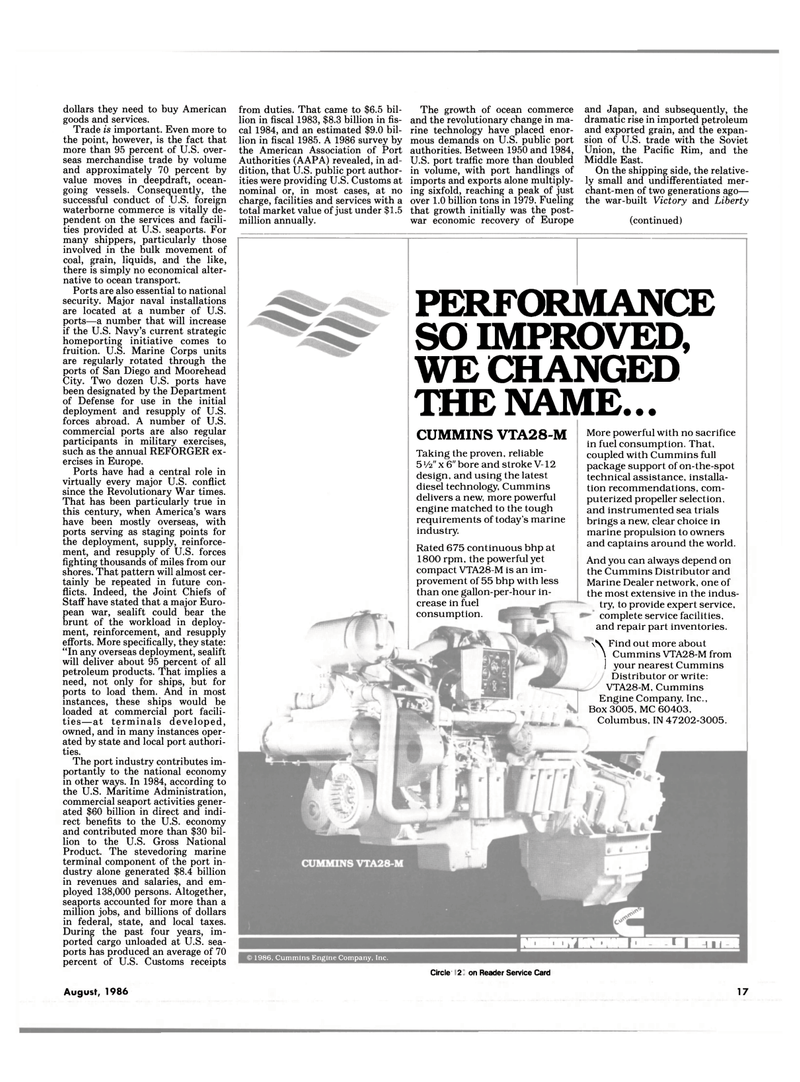
Page 15: of Maritime Reporter Magazine (August 1986)
Read this page in Pdf, Flash or Html5 edition of August 1986 Maritime Reporter Magazine
dollars they need to buy American goods and services.
Trade is important. Even more to the point, however, is the fact that more than 95 percent of U.S. over- seas merchandise trade by volume and approximately 70 percent by value moves in deepdraft, ocean- going vessels. Consequently, the successful conduct of U.S. foreign waterborne commerce is vitally de- pendent on the services and facili- ties provided at U.S. seaports. For many shippers, particularly those involved in the bulk movement of coal, grain, liquids, and the like, there is simply no economical alter- native to ocean transport.
Ports are also essential to national security. Major naval installations are located at a number of U.S. ports—a number that will increase if the U.S. Navy's current strategic homeporting initiative comes to fruition. U.S. Marine Corps units are regularly rotated through the ports of San Diego and Moorehead
City. Two dozen U.S. ports have been designated by the Department of Defense for use in the initial deployment and resupply of U.S. forces abroad. A number of U.S. commercial ports are also regular participants in military exercises, such as the annual REFORGER ex- ercises in Europe.
Ports have had a central role in virtually every major U.S. conflict since the Revolutionary War times.
That has been particularly true in this century, when America's wars have been mostly overseas, with ports serving as staging points for the deployment, supply, reinforce- ment, and resupply of U.S. forces fighting thousands of miles from our shores. That pattern will almost cer- tainly be repeated in future con- flicts. Indeed, the Joint Chiefs of
Staff have stated that a major Euro- pean war, sealift could bear the brunt of the workload in deploy- ment, reinforcement, and resupply efforts. More specifically, they state: "In any overseas deployment, sealift will deliver about 95 percent of all petroleum products. That implies a need, not only for ships, but for ports to load them. And in most instances, these ships would be loaded at commercial port facili- ties—at terminals developed, owned, and in many instances oper- ated by state and local port authori- ties.
The port industry contributes im- portantly to the national economy in other ways. In 1984, according to the U.S. Maritime Administration, commercial seaport activities gener- ated $60 billion in direct and indi- rect benefits to the U.S. economy and contributed more than $30 bil- lion to the U.S. Gross National
Product. The stevedoring marine terminal component of the port in- dustry alone generated $8.4 billion in revenues and salaries, and em- ployed 138,000 persons. Altogether, seaports accounted for more than a million jobs, and billions of dollars in federal, state, and local taxes.
During the past four years, im- ported cargo unloaded at U.S. sea- ports has produced an average of 70 percent of U.S. Customs receipts from duties. That came to $6.5 bil- lion in fiscal 1983, $8.3 billion in fis- cal 1984, and an estimated $9.0 bil- lion in fiscal 1985. A 1986 survey by the American Association of Port
Authorities (AAPA) revealed, in ad- dition, that U.S. public port author- ities were providing U.S. Customs at nominal or, in most cases, at no charge, facilities and services with a total market value of just under $1.5 million annually. © 1986, Cummins Engine Company, Inc.
The growth of ocean commerce and the revolutionary change in ma- rine technology have placed enor- mous demands on U.S. public port authorities. Between 1950 and 1984,
U.S. port traffic more than doubled in volume, with port handlings of imports and exports alone multiply- ing sixfold, reaching a peak of just over 1.0 billion tons in 1979. Fueling that growth initially was the post- war economic recovery of Europe
Circle 222 on Reader Service Card and Japan, and subsequently, the dramatic rise in imported petroleum and exported grain, and the expan- sion of U.S. trade with the Soviet
Union, the Pacific Rim, and the
Middle East.
On the shipping side, the relative- ly small and undifferentiated mer- chant-men of two generations ago— the war-built Victory and Liberty (continued)
PERFORMANCE SO IMPROVED,
WE CHANGED THE NAME...
CUMMINS VTA28-M
Taking the proven, reliable 5 ¥2" x 6" bore and stroke V-12 design, and using the latest diesel technology, Cummins delivers a new, more powerful engine matched to the tough requirements of today's marine industry.
Rated 675 continuous bhp at 1800 rpm, the powerful yet compact VTA28-M is an im- provement of 55 bhp with less than one gallon-per-hour in- crease in fuel consumption.
More powerful with no sacrifice in fuel consumption. That, coupled with Cummins full package support of on-the-spot technical assistance, installa- tion recommendations, com- puterized propeller selection, and instrumented sea trials brings a new, clear choice in marine propulsion to owners and captains around the world.
And you can always depend on the Cummins Distributor and
Marine Dealer network, one of the most extensive in the indus- try, to provide expert service, complete service facilities, and repair part inventories. \\ Find out more about \ Cummins VTA28-M from
I your nearest Cummins
Distributor or write:
VTA28-M, Cummins
Engine Company, Inc.,
Box 3005, MC 60403,
Columbus, IN 47202-3005.
NOBODY KNOWS DIESELS BETTER
August, 1986 17

 14
14

 16
16
